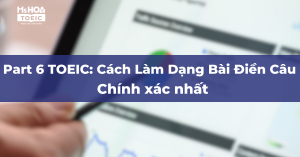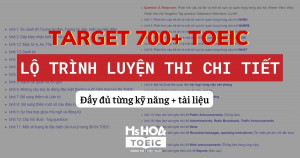Với level 500-700, cô sẽ giới thiệu cho các em các trường hợp đặc biệt và nâng cao của mệnh đề quan hệ bao gồm rút gọn Ving, Ved, to Vo, lược bỏ đại từ quan hệ và các bước làm bài chi tiết, cụ thể và dễ hiểu.
1. Active: Nếu mệnh đề quan hệ là mệnh đề chủ động thì rút thành cụm hiện tại phân từ (V-ing).
Ví dụ: - The man who stands at the door is my uncle. => The man who is / was standing at the door is my uncle.
- The man who stood at the door is my uncle.=> The man standing at the door is my uncle.
2. Passive: Ta có thể dùng past participle (V2ed) để thay thế cho mệnh đề đề quan hệ khi nó mang nghĩa bị động
Ví dụ: - The woman who is / was given a flower looks / looked very happy => The woman given a flower looks / looked very happy.
3. Rút thành cụm động từ nguyên mẫu - Infinitive relative clause (active / passive)
Mệnh đề quan hệ được rút thành cụm động từ nguyên mẫu (To-infinitive) khi trước đại từ quan hệ có các cụm từ: the first, the second, the last, the only hoặchình thức so sánh bậc nhất. Ví dụ
a. Active: - The first student who comes to class has to clean the board.
The first student to come to class has to clean the board.
b. Passive: - The only room which was painted yesterday was Mary’s.
The only room to be painted yesterday was Mary’s.
Notes: Chúng ta không sử dụng active hay passive to-infinitive sau an
|
Có thể các em sẽ cần: |
4. Mệnh đề rút gọn tính từ có dạng be và tính từ/cụm tính từ
- Công thức 1: BỎ who, which…to be -> GIỮ NGUYÊN tính từ phía sau.
- Nếu phía trước that là đại từ phiếm chỉ như something, anything, anybody…
Ex: There must be something that is wrong => There must be something wrong.
- Có dấu phẩy phía trước và phải có từ 2 tính từ trở lên.
Ex: My grandmother, who is old and sick, never goes out of the house => My grandmother, old and sick, never goes out of the house.
- Công thức 2: Những trường hợp còn lại ta đưa tính từ LÊN TRƯỚC danh từ
Ex: My grandmother, who is sick, never goes out of the house => My sick grandmother never goes out of the house.
I buy a hat which is very beautiful and fashionable => I buy a very beautiful and fashionable hat.
Tuy nhiên nếu cụm tính từ gồm cả danh từ ở trong nó thì ta chỉ còn cách dùng V-ing mà thôi.
Ex: I met a man who was very good at both English and French => I met a man being very good at both English and French.
Tóm lại cách rút gọn loại này khá phức tạp vì nó tùy thuộc vào đến 3 yếu tố: có một hay nhiều tính từ – danh từ đứng trước có phải là phiếm chỉ không có dấu phẩy hay không
5. Bài luyện tập
Sau đây là một số ví dụ để làm rõ hơn chủ điểm ngữ pháp trên:
- The teacher punishes anyone breaking the rules. (=...anyone who breaks rules.)
- I live in a building having forty storeys. (=....building which has forty...)
- The house painted in red is where John lives. (= The house which is painted in red....)
- People invited are expected to be formally dressed for the occasion. (= People who are invited .....)
>>> Một số bài tập luyện tập thêm
>>> Xem tiếp: Unit 6: Những điểm cần lưu ý trong MĐQH của kỳ thi TOEIC























